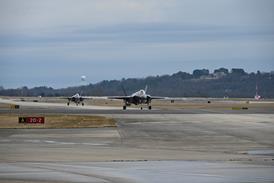Boeing modifications will allow Next Generation aircraft to operate with increased payloads from restricted runways
Brazilian carrier Gol is launch customer for a short-field performance enhancement package devised by Boeing for the Next Generation 737 and aimed at increasing payload in and out of restricted runways.
The package, aimed initially at the longer-body -800, -900 and yet-be-launched -900X variants, is expected to enter service on Gol's 737-800s in the second quarter of 2006 after flight tests and certification work starting in the fourth quarter of 2005.
The package could then be introduced on the -900 and the follow-on -900X, now pencilled in for entry into service in the first quarter of 2007.
The package, some parts of which can be applied to the shorter -600/700 models for more moderate performance gains, consists of aerodynamic, structural and avionics modifications. Probably the most significant is the addition of an actuator to the curved seal between the outboard section of the wing leading-edge Krueger flap and the adjacent inboard skin of the engine nacelle.
The modification will replace the current spring-loaded seal and will allow the section to be sealed for take-off and opened up when landing flap is selected. "When we did windtunnel tests, we found a lift benefit for landing," says 737 chief project engineer Mike Delaney, who adds the increased flow will enhance low-speed lift.
Another part of the package, and one that is potentially adaptable for all models, is an increase in flight-spoiler deflection on the ground. The 737 has six spoilers on each wing, the inboard and outboard of which are dedicated ground spoilers capable of deflecting up to 60°.
The middle four flight spoilers can now deploy only between 33° and 38° on the ground roll, and these will now be fitted with increased-stroke actuators to match the 60° deployment of the other spoilers and increase the aircraft's braking capability.
Elements of the package aimed at the longer models include an increase in the sealed slat for take-off position to 15° flap, and an optional two-position tailskid that can be extended an extra 127mm (5in) for landing.
The seal expansion beyond the current 10° flap maximum allows the wing to generate more lift at the lower rotation angles of the -800/900 models, while the tailskid option is designed to allow for slightly increased final approach and flare angles.
The modifications will be accompanied by revisions to the flight management computer (FMC) and flight-control system scheduling software.
GUY NORRIS / LOS ANGELES
Source: Flight International























